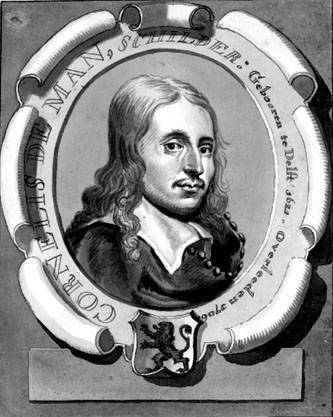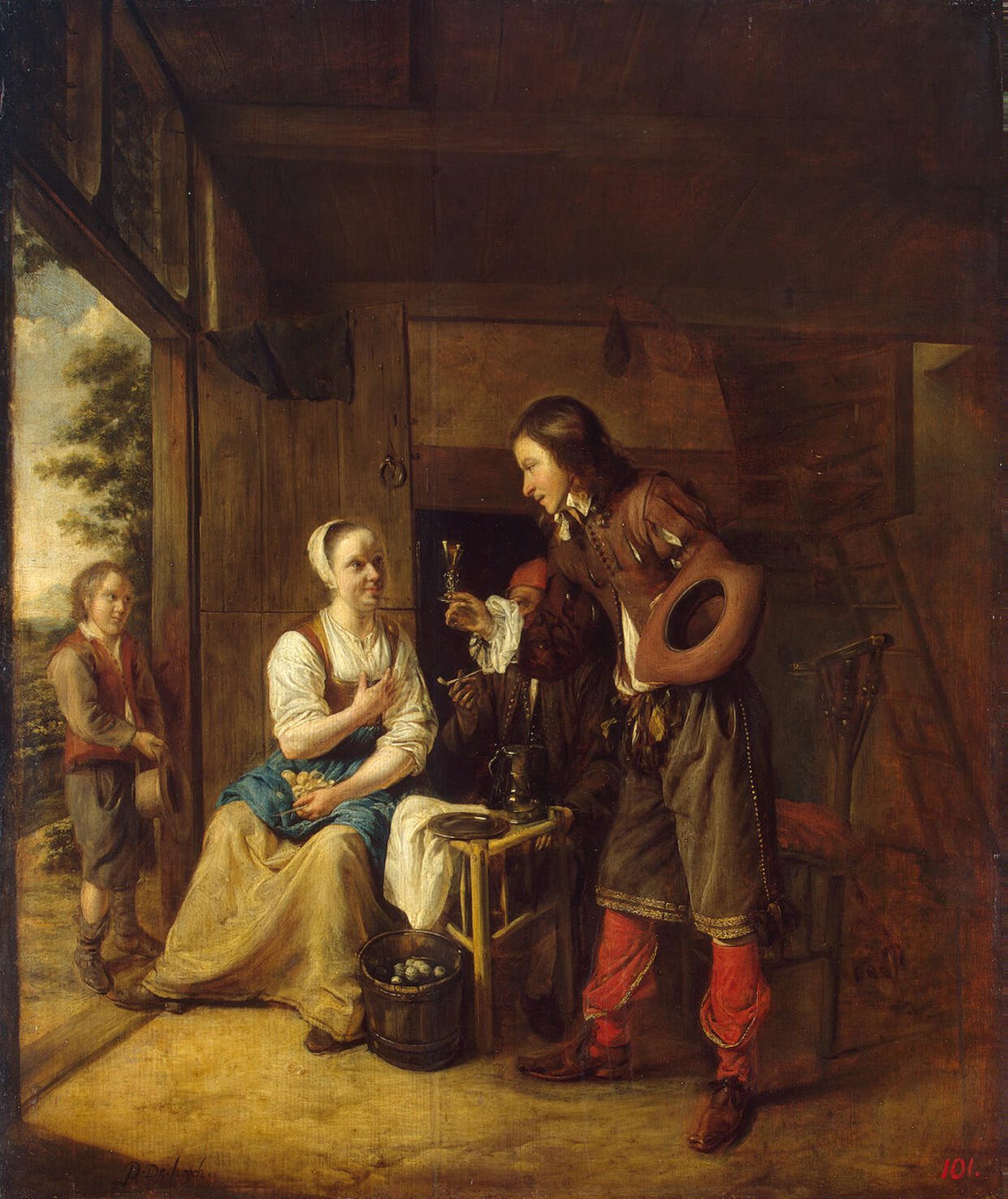|
Cornelis De Man
Cornelis de Man (1 July 1621, in Delft – 1 September 1706, in Delft) was a Dutch Golden Age painter. Biography As a young man, Kornelis was not satisfied with life in Delft. He wanted to travel beyond the port of Dordrecht and that is what he did, spending a year in Paris as soon as he came of age and had enough talent to pay his way with his painting skills. According to the RKD (Netherlands Institute for Art History) he became a member of the Delft Guild of St. Luke in 1642 and ultimately travelled to Italy.Cornelis de Man in the He was well-received in Paris at the outset of his travels, but set off in the Spring for [...More Info...] [...Related Items...] OR: [Wikipedia] [Google] [Baidu] |
Pieter De Hooch
Pieter Hendricksz. de Hooch (; also spelled ''Hoogh'' or ''Hooghe''; 20 December 1629 – after 1683), was a Dutch Golden Age painter famous for his genre works of quiet domestic scenes with an open doorway. He was a contemporary, in the Delft Guild of St. Luke, of Jan Vermeer with whom his work shares themes and style. De Hooch was first recorded in Delft on 5 August 1652, when he and another painter, Hendrick van der Burgh witnessed the signing of a will. He was active in 1683, but his date of death is unknown (his son Pieter died in 1684, a date often wrongly given for the father). Biography De Hooch was born in Rotterdam to Hendrick Hendricksz de Hooch, a bricklayer, and Annetge Pieters, a midwife, baptised at the Reformed Church in Rotterdam in 1629. He was the eldest of five children and outlived all of his siblings, evidently raised in a working class home. Though, his father was described as a "master bricklayer", hence a skilled artisan required to be a member ... [...More Info...] [...Related Items...] OR: [Wikipedia] [Google] [Baidu] |
Dutch Golden Age Painters
Dutch Golden Age painting is the painting of the Dutch Golden Age, a period in Dutch history roughly spanning the 17th century, during and after the later part of the Eighty Years' War (1568–1648) for Dutch independence. The new Dutch Republic was the most prosperous nation in Europe and led European trade, science, and art. The northern Terminology of the Low Countries, Netherlandish provinces that made up the new state had traditionally been less important artistic centres than cities in Flanders in the south. The upheavals and large-scale transfers of population of the war, and the sharp break with the old monarchist and Catholic cultural traditions, meant that Dutch art had to reinvent itself almost entirely, a task in which it was very largely successful. The painting of religious subjects declined very sharply, but a large new market for all kinds of secular subjects grew up. Although Dutch painting of the Golden Age is included in the general European period of Baroque ... [...More Info...] [...Related Items...] OR: [Wikipedia] [Google] [Baidu] |
1706 Deaths
In the Swedish calendar it was a common year starting on Monday, one day ahead of the Julian and ten days behind the Gregorian calendar. Events January–March * January 26 ** War of Spanish Succession: The uprising by Bavarians against the occupation of the Electorate of Bavaria by Austrian troops ends after 75 days, and ends the plans of Maximilian, the Elector of Bavaria, to bring Bavaria under the rule of the House of Wittelsbach. ** Great Northern War – Battle of Grodno: A coalition of 34,000 Swedish and Polish troops besieges the then-Lithuanian city in the winter time, and clashes with 41,000 Russian and Saxon troops. After almost three months of fighting that lasts to April 10, Sweden takes control of the city, which is now located in Belarus. * February 6 – The city of Albuquerque, New Mexico, is incorporated by governor Don Francisco Cuervo y Valdes as ''La Villa de Alburquerque'' in the Spanish colonial province of Santa Fe de Nuevo Méxic ... [...More Info...] [...Related Items...] OR: [Wikipedia] [Google] [Baidu] |
1621 Births
Events January–March * January 12 – Şehzade Mehmed (son of Ahmed I), Şehzade Mehmed, the 15-year old half-brother of Ottoman Sultan Osman II, is put to death by hanging on Osman's orders. Before dying, Mehmed prays aloud that Osman's reign as Sultan be ruined. * January 18 – The Dutch East India Company formally names its fortress at Jayakarta in Indonesia, calling it Jakarta, Batavia. Upon the independence of the Dutch East Indies as Indonesia in 1945, Batavia will be renamed Jakarta. * January 22 – The Tianqi (era), Tianqi era begins in Ming Dynasty China, six months after Zhu Changluo becomes the Taichang Emperor. * January 24 – Twelve days after the murder of Prince Mehmed on orders of Sultan Osman II, Constantinople is hit by bitter winter weather, leading to rioting by persons who believe that the punishment of Osman is the will of Allah. * January 28 – Pope Paul V (Camillo Borghese) dies at the age of 70 after 15 years as Pont ... [...More Info...] [...Related Items...] OR: [Wikipedia] [Google] [Baidu] |
Rijksmuseum Amsterdam
The Rijksmuseum () is the national museum of the Netherlands dedicated to Dutch arts and history and is located in Amsterdam. The museum is located at the Museumplein, Museum Square in the stadsdeel, borough of Amsterdam-Zuid, Amsterdam South, close to the Van Gogh Museum, the Stedelijk Museum Amsterdam, and the Concertgebouw, Amsterdam, Concertgebouw. The Rijksmuseum was founded in The Hague on 19 November 1798 and moved to Amsterdam in 1808, where it was first located in the Royal Palace (Amsterdam), Royal Palace and later in the Trippenhuis. The current main building was designed by Pierre Cuypers and first opened in 1885.The renovation Rijksmuseum. Retrieved on 4 April 2013. On 13 April 2013, after a ten-year renovation which cost euro, €375 million, the main building was reopened by Beatrix of the Netherla ... [...More Info...] [...Related Items...] OR: [Wikipedia] [Google] [Baidu] |
Denmark
Denmark is a Nordic countries, Nordic country in Northern Europe. It is the metropole and most populous constituent of the Kingdom of Denmark,, . also known as the Danish Realm, a constitutionally unitary state that includes the Autonomous administrative division, autonomous territories of the Faroe Islands and Greenland in the north Atlantic Ocean.* * * Metropolitan Denmark, also called "continental Denmark" or "Denmark proper", consists of the northern Jutland peninsula and an archipelago of 406 islands. It is the southernmost of the Scandinavian countries, lying southwest of Sweden, south of Norway, and north of Germany, with which it shares a short border. Denmark proper is situated between the North Sea to the west and the Baltic Sea to the east.The island of Bornholm is offset to the east of the rest of the country, in the Baltic Sea. The Kingdom of Denmark, including the Faroe Islands and Greenland, has roughly List of islands of Denmark, 1,400 islands greater than in ... [...More Info...] [...Related Items...] OR: [Wikipedia] [Google] [Baidu] |
Spitsbergen
Spitsbergen (; formerly known as West Spitsbergen; Norwegian language, Norwegian: ''Vest Spitsbergen'' or ''Vestspitsbergen'' , also sometimes spelled Spitzbergen) is the largest and the only permanently populated island of the Svalbard archipelago in northern Norway in the Arctic Ocean. Constituting the westernmost bulk of the archipelago, it borders the Arctic Ocean, the Norwegian Sea and the Greenland Sea. Spitsbergen covers an area of , making it the largest island in Norway and the List of islands by area, 36th largest in the world. The administrative centre is Longyearbyen. Other settlements, in addition to research outposts, are the mining community of Barentsburg, the research community of Ny-Ålesund, and the mining outpost of Sveagruva. Spitsbergen was covered in of ice in 1999, which was approximately 58.5% of the island's total area. The island was first used as a whaling base in the 17th and 18th centuries, after which it was abandoned. Coal mining started at the e ... [...More Info...] [...Related Items...] OR: [Wikipedia] [Google] [Baidu] |
Dutch East India Company
The United East India Company ( ; VOC ), commonly known as the Dutch East India Company, was a chartered company, chartered trading company and one of the first joint-stock companies in the world. Established on 20 March 1602 by the States General of the Netherlands amalgamating Voorcompagnie, existing companies, it was granted a 21-year monopoly to carry out trade activities in Asia. Shares in the company could be purchased by any citizen of the Dutch Republic and subsequently bought and sold in open-air secondary markets (one of which became the Amsterdam Stock Exchange). The company possessed quasi-governmental powers, including the ability to wage war, imprison and execute convicts, negotiate treaties, strike Coinage of the Dutch East India Company, its own coins, and establish colonies. Also, because it traded across multiple colonies and countries from both the East and the West, the VOC is sometimes considered to have been the world's first multinational corporation. St ... [...More Info...] [...Related Items...] OR: [Wikipedia] [Google] [Baidu] |
Noordsche Compagnie
The Noordsche Compagnie () was a Dutch cartel in the whaling trade, founded by several cities in the Netherlands in 1614 and operating until 1642. Soon after its founding, it became entangled in territorial conflicts with England, Denmark-Norway, France, and other groups within the Netherlands. It was also known as the Groenlandse Compagnie (), but the name is misleading today since the "Greenland" referred to is Svalbard, previously thought to either be identical or connected to the island of Greenland discovered and colonized by the Norse. History In 1598, a whale beached at Wijk aan Zee. The animal was sold for 126 guilders and the jaw was transported to Dillenburg and given to Jan van Nassau as a gift. In 1612, the first mention is made of a commercial expedition to Novaya Zemlya after it was concluded that whaling at the Cape of Good Hope in the southern Atlantic offered little prospects of profit. Willem Cornelisz. van Muyden was one of the first skippers to set sa ... [...More Info...] [...Related Items...] OR: [Wikipedia] [Google] [Baidu] |






